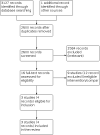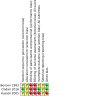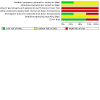Timing of antibiotic administration, wound debridement, and the stages of reconstructive surgery for open long bone fractures of the upper and lower limbs
- PMID: 35363374
- PMCID: PMC8973274
- DOI: 10.1002/14651858.CD013555.pub2
Timing of antibiotic administration, wound debridement, and the stages of reconstructive surgery for open long bone fractures of the upper and lower limbs
Abstract
Background: Open fractures of the major long bones are complex limb-threatening injuries that are predisposed to deep infection. Treatment includes antibiotics and surgery to debride the wound, stabilise the fracture and reconstruct any soft tissue defect to enable infection-free bone repair. There is a need to assess the effect of timing and duration of antibiotic administration and timing and staging of surgical interventions to optimise outcomes.
Objectives: To assess the effects (risks and benefits) of the timing of antibiotic administration, wound debridement and the stages of surgical interventions in managing people with open long bone fractures of the upper and lower limbs.
Search methods: We searched the Cochrane Central Register of Controlled Trials (CENTRAL), MEDLINE, Embase and clinical trial registers in February 2021. We also searched conference proceedings and reference lists of included studies.
Selection criteria: We included randomised controlled trials (RCTs) or quasi-RCTs that recruited adults with open fractures of the major long bones, comparing: 1) timings of prophylactic antibiotic treatment, 2) duration of prophylactic antibiotic treatment, 3) timing of wound debridement following injury or 4) timing of the stages of reconstructive surgery.
Data collection and analysis: We used standard methodological procedures expected by Cochrane. We aimed to collect data for the following outcomes: limb function, health-related quality of life (HRQoL), deep surgical site infection, delayed or non-union, adverse events (in the short- and long-term course of recovery), and resource-related outcomes.
Main results: We included three RCTs of 613 randomised participants with 617 open fractures. Studies were conducted in medical and trauma centres in the USA and Kenya. Where reported, there was a higher proportion of men and a mean age of participants between 30 and 34 years old. Fractures were in the upper and lower limbs in one study, and were tibia fractures in two studies; where reported, these were the result of high-energy trauma such as road traffic accidents. No studies compared the timing of antibiotic treatment or wound debridement. Duration of prophylactic antibiotic treatment (1 study, 77 participants available for analysis) One study compared antibiotic treatment for 24 hours with antibiotic treatment for five days. We are very uncertain about the effects of different durations of antibiotic treatment on superficial infections (risk ratio (RR) 1.19, 95% CI 0.49 to 2.87, favours 5 day treatment; 1 study, 77 participants); this was very low-certainty evidence derived from one small study with unclear and high risks of bias, and with an imprecise effect estimate. This study reported no other review outcomes. Reconstructive surgery: timing of the stages of surgery (2 studies, 458 participants available for analysis) Two studies compared the timing of wound closure, which was completed immediately or delayed. In one study, the mean time of delay was 5.9 days; in the other study, the time of delay was not reported. We are very uncertain about the effects of different timings of wound closure on deep infections (RR 0.82, 95% CI 0.37 to 1.80, favours immediate closure; 2 studies, 458 participants), delayed union or non-union (RR 1.13, 95% CI 0.83 to 1.55, favours delayed closure; 1 study, 387 participants), or superficial infections (RR 6.45, 95% CI 0.35 to 120.43, favours delayed closure; 1 study, 71 participants); this was very low-certainty evidence. We downgraded the certainty of the evidence for very serious risks of bias because both studies had unclear and high risks of bias. We also downgraded for serious imprecision because effect estimates were imprecise, including the possibility of benefits as well as harms, and very serious imprecision when the data were derived from single small study. These studies reported no other review outcomes.
Authors' conclusions: We could not determine the risks and benefits of different treatment protocols for open long bone fractures because the evidence was very uncertain for the two comparisons and we did not find any studies addressing the other possible comparisons. Well-designed randomised trials with adequate power are needed to guide surgical and antibiotic treatment of open fractures, particularly with regard to timing and duration of antibiotic administration and timing and staging of surgery.
Copyright © 2022 The Cochrane Collaboration. Published by John Wiley & Sons, Ltd.
Conflict of interest statement
JC: Cochrane UK Fellow 2017 to 2018. AA: none SL: none. SL was not involved in the editorial process. JR: funded by the NIHR. This represents independent research funded by the NIHR. The views expressed are the author's own, and are not necessarily those of the NIHR, NHS or the Department of Health and Social Care. XG: works within a research group that has been funded for several trials of negative pressure dressings and has published trials that may be relevant to this review. He has ongoing expert consultancy with several companies. XG is fully funded by the NIHR. The views expressed are the author's own and are not necessarily those of the NIHR, NHS or the Department of Health and Social Care. XG was not involved in the editorial process. JN: co‐applicant on an NIHR‐funded trial for negative pressure wound therapy for closed incisions in people with major trauma of the lower limb ‐ Wound Healing in Surgery for Trauma (WHIST). He has also lectured on courses on the management of open fractures, sponsored by orthopaedic implant manufacturers. JN is member of the NICE Guidance Development Group for Complex and Non‐Complex Fractures. JN is an expert witness providing medico‐legal reports including on open fractures.
Figures








Update of
- doi: 10.1002/14651858.CD013555
Similar articles
-
Ultrasound and shockwave therapy for acute fractures in adults.Cochrane Database Syst Rev. 2023 Mar 3;3(3):CD008579. doi: 10.1002/14651858.CD008579.pub4. Cochrane Database Syst Rev. 2023. PMID: 36866917 Free PMC article.
-
Interventions for necrotizing soft tissue infections in adults.Cochrane Database Syst Rev. 2018 May 31;5(5):CD011680. doi: 10.1002/14651858.CD011680.pub2. Cochrane Database Syst Rev. 2018. PMID: 29851032 Free PMC article.
-
Negative pressure wound therapy for open traumatic wounds.Cochrane Database Syst Rev. 2018 Jul 3;7(7):CD012522. doi: 10.1002/14651858.CD012522.pub2. Cochrane Database Syst Rev. 2018. PMID: 29969521 Free PMC article.
-
Cephalomedullary nails versus extramedullary implants for extracapsular hip fractures in older adults.Cochrane Database Syst Rev. 2022 Jan 26;1(1):CD000093. doi: 10.1002/14651858.CD000093.pub6. Cochrane Database Syst Rev. 2022. PMID: 35080771 Free PMC article.
-
Interventions for treating supracondylar elbow fractures in children.Cochrane Database Syst Rev. 2022 Jun 9;6(6):CD013609. doi: 10.1002/14651858.CD013609.pub2. Cochrane Database Syst Rev. 2022. PMID: 35678077 Free PMC article.
Cited by
-
Analysis of the Risk Factors for Free Flap Necrosis in Soft Tissue Reconstruction of the Lower Limbs.Orthop Surg. 2023 Jun;15(6):1534-1540. doi: 10.1111/os.13727. Epub 2023 Apr 24. Orthop Surg. 2023. PMID: 37092532 Free PMC article.
-
Assessing the risks of children with preoperative comorbidities undergoing comminuted fracture surgery.Front Pediatr. 2023 Feb 20;11:1118954. doi: 10.3389/fped.2023.1118954. eCollection 2023. Front Pediatr. 2023. PMID: 36891228 Free PMC article.
-
Open tibial fractures: An overview.J Clin Orthop Trauma. 2021 Jun 24;20:101483. doi: 10.1016/j.jcot.2021.101483. eCollection 2021 Sep. J Clin Orthop Trauma. 2021. PMID: 34262849 Free PMC article.
-
Surgical site application of antibiotics: A potential game changer for fracture-related infection care and antibiotic stewardship.J Orthop. 2023 Oct 31;46:139-142. doi: 10.1016/j.jor.2023.10.032. eCollection 2023 Dec. J Orthop. 2023. PMID: 38009080 Free PMC article. No abstract available.
-
Bacterial Contamination of Open Fractures: Pathogens and Antibiotic Resistance Patterns in East China.J Pers Med. 2023 Apr 26;13(5):735. doi: 10.3390/jpm13050735. J Pers Med. 2023. PMID: 37240904 Free PMC article.
References
References to studies included in this review
Benson 1983 {published data only}
-
- Benson DR, Riggins RS, Lawrence RM, Hoeprich PD, Huston AC, Harrison JA.Treatment of open fractures: a prospective study. Journal of Trauma 1983;23(1):25-30. - PubMed
Ondari 2016 {published data only}
-
- Ondari JN, Masika MM, Ombachi RB, Ating'a JE.Unblinded randomized control trial on prophylactic antibiotic use in Gustilo II open tibia fractures at Kenyatta National Hospital, Kenya. Injury 2016;47(10):2288-93. [PMID: ] - PubMed
-
- PACTR201606001689132.Unblinded randomized control trial on prophylactic antibiotic use in Gustilo II open tibia fractures at Kenyatta National Hospital, Kenya. pactr.samrc.ac.za/Search.aspx (first received 21 June 2016). - PubMed
Russell 2005 {published data only (unpublished sought but not used)}
-
- Russell G, Laurent S, Sasser H, OTA Open Fracture Study Group.Immediate versus delayed closure of grade II and IIIA tibial fractures: a prospective, randomized, multicenter study. In: OTA Abstracts Session XI - Tibia Paper # 47. ota.org/education/meetings-and-courses/abstracts/immediate-versus-delaye.... 22 October 2005.
References to studies excluded from this review
Bergman 1982 {published data only}
-
- Bergman BR.Antibiotic prophylaxis in open and closed fractures: a controlled clinical trial. Acta Orthopaedica Scandinavica 1982;53(299):57-62. [PMID: ] - PubMed
Braun 1987 {published data only}
-
- Braun R, Enzler MA, Rittmann WW.A double-blind clinical trial of prophylactic cloxacillin in open fractures. Journal of Orthopaedic Trauma 1987;1(1):12-7. [PMID: ] - PubMed
Carsenti‐Etesse 1999 {published data only}
-
- Carsenti-Etesse H, Doyon F, Desplaces N, Gagey O, Tancrede C, Pradier C, et al.Epidemiology of bacterial infection during management of open leg fractures. European Journal of Clinical Microbiology & Infectious Diseases 1999;18(5):315-23. [PMID: ] - PubMed
-
- Gagey O, Doyon F, Dellamonica P, Carsenti-Etesse H, Desplaces N, Tancrede C, et al.Infection prophylaxis in open leg fractures. Comparison of a dose of pefloxacin and 5 days of cefazolin-oxacillin. A randomized study of 616 cases. Revue de Chirurgie Orthopedique et Reparatrice de l'Appareil Moteur 1999;85(4):328-36. [PMID: ] - PubMed
-
- Gagey O, Doyon F, Desplaces N, la Monica P, Tancrede C, Delavault P, et al.A controlled study of prophylactic antibiotic treatment of open fractures of the tibia (single dose of Pefloxacine versus five days of Cephazoline and Oxacillin): a series of 616 patients. Journal of Bone and Joint Surgery. British Volume 1997;79(Suppl 1):63.
Mahajan 2016 {published data only}
Moehring 2000 {published data only}
-
- Moehring HD, Gravel C, Chapman MW, Olson SA.Comparison of antibiotic beads and intravenous antibiotics in open fractures. Clinical Orthopaedics and Related Research 2000;372(372):254-61. [PMID: ] - PubMed
NCT04678154 {published data only}
-
- NCT04678154.Evaluation of a new strategy for protocolized antibiotic care for severe open fractures: SEXTANT. clinicaltrials.gov/ct2/show/NCT04678154 (first received 21 December 2020).
Pape 2007 {published data only}
-
- Pape HC, Rixen D, Morley J, Husebye EE, Mueller M, Dumont C, et al, Epoff Study Group.Impact of the method of initial stabilization for femoral shaft fractures in patients with multiple injuries at risk for complications (borderline patients). Annals of Surgery 2007;246(3):491-9. [PMID: ] - PMC - PubMed
Patzakis 1996 {published data only}
-
- Patzakis MJ, Bains RS, Lee J, Shepherd L, Holtom P, Harvey F.A prospective randomized double blind study comparing single agent antibiotic therapy, ciprofloxacin, to combination antibiotic therapy in open fracture wounds. Orthopaedic Transactions 1996;20(1):25. - PubMed
-
- Patzakis MJ, Bains RS, Lee J, Shepherd L, Singer G, Ressler R, et al.Prospective, randomized, double-blind study comparing single-agent antibiotic therapy, ciprofloxacin, to combination antibiotic therapy in open fracture wounds. Journal of Orthopaedic Trauma 2000;14(8):529-33. [PMID: ] - PubMed
Saveli 2013 {published data only}
-
- Saveli CC, Morgan SJ, Belknap RW, Ross E, Stahel PF, Chaus GW, et al.Prophylactic antibiotics in open fractures: a pilot randomized clinical safety study. Journal of Orthopaedic Trauma 2013;27(10):552-7. [PMID: ] - PubMed
Additional references
Audige 2005
-
- Audige L, Griffin D, Bhandari M, Kellam J, Ruedi TP.Path analysis of factors for delayed healing and nonunion in 416 operatively treated tibial shaft fractures. Clinical Orthopaedics and Related Research 2005;438:221-32. - PubMed
Bergner 1981
-
- Bergner M, Bobbitt RA, Carter WB, Gilson BS.The Sickness Impact Profile: development and final revision of a health status measure. Medical Care 1981;19(8):787-805. - PubMed
Binkley 1999
-
- Binkley JM, Stratford PW, Lott SA, Riddle DL.The Lower Extremity Functional Scale (LEFS): scale development, measurement properties, and clinical application. North American Orthopaedic Rehabilitation Research Network. Physical Therapy 1999;79(4):371-83. - PubMed
Bondurant 1988
-
- Bondurant FJ, Cotler HB, Buckle R, Miller-Crotchett P, Browner BD.The medical and economic impact of severely injured lower extremities. Journal of Trauma and Acute Care Surgery 1988;28(8):1270-3. - PubMed
Brazier 2002
-
- Brazier J, Roberts J, Deverill M.The estimation of a preference-based measure of health from the SF-36. Journal of Health Economics 2002;21(2):271-92. - PubMed
British Orthopaedic Association 2017
-
- British Orthopaedic Association, British Association of Plastic, Reconstructive and Aesthetic Surgeons.Open fractures; 2017. Available at www.boa.ac.uk/static/3b91ad0a-9081-4253-92f7d90e8df0fb2c/29bf80f1-1cb6-4....
Brooks 1996
-
- Brooks R.EuroQol: the current state of play. Health Policy 1996;37(1):53-72. - PubMed
Chan 2012
Chang 2019
-
- Chang Y, Bhandari M, Zhu KL, Mirza RD, Ren M, Kennedy SA, et al.Antibiotic prophylaxis in the management of open fractures: a systematic survey of current practice and recommendations. JBJS Reviews 2019;7(2):e1. - PubMed
Chen 2017
-
- Chen W, Lv H, Liu S, Liu B, Zhu Y, Chen X, et al.National incidence of traumatic fractures in China: a retrospective survey of 512,187 individuals. Lancet Global Health 2017;5(8):e807-17. - PubMed
Costa 2018
-
- Costa ML, Achten J, Bruce J, Tutton E, Petrou S, Lamb SE, et al.Effect of negative pressure wound therapy vs standard wound management on 12-month disability among adults with severe open fracture of the lower limb: the WOLLF randomized clinical trial. Journal of the American Medical Association 2018;319(22):2280-8. - PMC - PubMed
Court‐Brown 2012
-
- Court-Brown CM, Bugler KE, Clement ND, Duckworth AD, McQueen MM.The epidemiology of open fractures in adults. A 15-year review. Injury 2012;43(6):891-7. - PubMed
Covidence [Computer program]
-
- Covidence systematic review software.Version accessed on 12 November 2020. Melbourne, Australia: Veritas Health Innovation. Available at www.covidence.org.
de Bruin 1994
-
- Bruin AF, Diederiks JP, Witte LP, Stevens FC, Philipsen H.The development of a short generic version of the Sickness Impact Profile. Journal of Clinical Epidemiology 1994;47(4):407-18. - PubMed
Deeks 2021
-
- Deeks JJ, Higgins JP, Altman DG, editor(s).Chapter 10: Analysing data and undertaking meta-analyses. In: Higgins JP, Thomas J, Chandler J, Cumpston M, Li T, Page MJ, Welch VA, editor(s). Cochrane Handbook for Systematic Reviews of Interventions version 6.2 (updated February 2021). Cochrane, 2021. Available from www.training.cochrane.org/handbook.
Dolan 1997
-
- Dolan P.Modeling valuations for EuroQol health states. Medical Care 1997;35(11):1095-108. - PubMed
Eccles 2020
-
- Eccles S, Handley B, Khan U, McFadyen, Nanchahal J, Nayagam S, editor(s).Standards for the management of open fractures. oxfordmedicine.com/view/10.1093/med/9780198849360.001.0001/med-978019884... (accessed 1 February 2020). [DOI: 10.1093/med/9780198849360.001.0001] - DOI
Enneking 1993
-
- Enneking WF, Dunham W, Gebhardt MC, Malawar M, Pritchard DJ.A system for the functional evaluation of reconstructive procedures after surgical treatment of tumors of the musculoskeletal system. Clinical Orthopaedics and Related Research 1993;286:241-6. - PubMed
Gillespie 2010
Glass 2011
-
- Glass GE, Barrett SP, Sanderson F, Pearse MF, Nanchahal J.The microbiological basis for a revised antibiotic regimen in high-energy tibial fractures: preventing deep infections by nosocomial organisms. Journal of Plastic Reconstructive and Aesthetic Surgery 2011;64(3):375-80. - PubMed
Godina 1986
-
- Godina M.Early microsurgical reconstruction of complex trauma of the extremities. Plastic Reconstructive Surgery 1986;78(3):285-92. - PubMed
Gopal 2000
-
- Gopal S, Majumder S, Batchelor AG, Knight SL, De Boer P, Smith RM.Fix and flap: the radical orthopaedic and plastic treatment of severe open fractures of the tibia. Journal of Bone and Joint Surgery. British Volume 2000;82(7):959-66. - PubMed
Gopal 2004
-
- Gopal S, Giannoudis PV, Murray A, Matthews SJ, Smith RM.The functional outcome of severe, open tibial fractures managed with early fixation and flap coverage. Journal of Bone and Joint Surgery. British Volume 2004;86(6):861-7. - PubMed
Gosselin 2004
Gustilo 1976
-
- Gustilo RB, Anderson JT.Prevention of infection in the treatment of one thousand and twenty-five open fractures of long bones: retrospective and prospective analyses. Journal of Bone and Joint Surgery. American Volume 1976;58(4):453-8. - PubMed
Gustilo 1984
-
- Gustilo RB, Mendoza RM, Williams DN.Problems in the management of type III (severe) open fractures: a new classification of type III open fractures. Journal of Trauma 1984;24(8):742-6. - PubMed
Harris 2009
-
- Harris AM, Althausen PL, Kellam J, Bosse MJ, Castillo R, Lower Extremity Assessment Project Study Group.Complications following limb-threatening lower extremity trauma. Journal of Orthopaedic Trauma 2009;23(1):1-6. - PubMed
Hedges 1982
-
- Hedges LV.Fitting continuous models to effect size data. Journal of Educational and Behavioral Statistics 1982;7(4):245-70.
Higgins 2017
-
- Higgins JP, Altman DG, Sterne JA, editor(s).Chapter 8: Assessing risk of bias in included studies. In: Higgins JP, Churchill R, Chandler J, Cumpston MS, editor(s), Cochrane Handbook for Systematic Reviews of Interventions version 5.2.0 (updated June 2017). Cochrane, 2017. Available from www.training.cochrane.org/handbook.
Horan 2008
-
- Horan TC, Andrus M, Dudeck MA.CDC/NHSN surveillance definition of health care-associated infection and criteria for specific types of infections in the acute care setting. American Journal of Infection Control 2008;36(5):309-32. - PubMed
Høiby 2015
-
- Høiby N, Bjarnsholt T, Moser C, Bassi GL, Coenye T, Donelli G, et al, ESCMID Study Group for Biofilms and Consulting External Expert Werner Zimmerli.ESCMID guideline for the diagnosis and treatment of biofilm infections 2014. Clinical Microbiology and Infection 2015;21(Suppl 1):S1-25. [PMID: ] - PubMed
Iheozor‐Ejiofor 2018
Jenkinson 1999
Keating 2000
-
- Keating JF, Blachut PA, O'Brien PJ, Court-Brown CM.Reamed nailing of Gustilo grade-IIIB tibial fractures. Journal of Bone and Joint Surgery British Volume 2000;82(8):1113-6. - PubMed
Kuripla 2021
-
- Kuripla C, Tornetta P 3rd, Foote CJ, Koh J, Sems A, Shamaa T, et al.Timing of flap coverage with respect to definitive fixation in open tibia fractures. Journal of Orthopaedic Trauma 2021;35(8):430-6. [PMID: ] - PubMed
Lefebvre 2021
-
- Lefebvre C, Glanville J, Briscoe S, Littlewood A, Marshall C, Metzendorf M-I, et al.Chapter 4: Searching for and selecting studies. In: Higgins JP, Thomas J, Chandler J, Cumpston M, Li T, Page MJ, Welch VA, editor(s). Cochrane Handbook for Systematic Reviews of Interventions version 6.2 (updated February 2021). Cochrane 2021. Available www.training.cochrane.org/handbook.
Liu 2012
-
- Liu DS, Sofiadellis F, Ashton M, MacGill K, Webb A.Early soft tissue coverage and negative pressure wound therapy optimises patient outcomes in lower limb trauma. Injury 2012;43(6):772-8. - PubMed
Mathews 2015
-
- Mathews JA, Ward J, Chapman TW, Khan UM, Kelly MB.Single-stage orthoplastic reconstruction of Gustilo-Anderson Grade III open tibial fractures greatly reduces infection rates. Injury 2015;46(11):2263-6. - PubMed
NICE 2016
-
- NICE.Fractures (complex): assessment and management NG37; 2016. www.nice.org.uk/guidance/ng37.
Parker 2018
-
- Parker B, Petrou S, Masters JP, Achana F, Costa ML.Economic outcomes associated with deep surgical site infection in patients with an open fracture of the lower limb. The Bone & Joint Journal 2018;100-B(11):1506-10. - PubMed
Pollak 2000
-
- Pollak AN, McCarthy ML, Burgess AR.Short-term wound complications after application of flaps for coverage of traumatic soft-tissue defects about the tibia. The Lower Extremity Assessment Project (LEAP) Study Group. Journal of Bone and Joint Surgery. American Volume 2000;82-A(12):1681-91. - PubMed
Review Manager 2020 [Computer program]
-
- Review Manager 5 (RevMan).Version 5.4. Copenhagen: Nordic Cochrane Centre, The Cochrane Collaboration, 2020.
Salen 1994
-
- Salen BA, Spangfort EV, Nygren AL, Nordemar R.The Disability Rating Index: an instrument for the assessment of disability in clinical settings. Journal of Clinical Epidemiology 1994;47(12):1423-35. - PubMed
Schünemann 2021
-
- Schünemann HJ, Higgins JP, Vist GE, Glasziou P, Akl EA, Skoetz N, et al.Chapter 14: Completing ‘Summary of findings’ tables and grading the certainty of the evidence. In: Higgins JP, Thomas J, Chandler J, Cumpston M, Li T, Page MJ, Welch VA, editor(s). Cochrane Handbook for Systematic Reviews of Interventions version 6.3 (updated February 2022). Cochrane, 2022. Available from www.training.cochrane.org/handbook.
Seekamp 1996
-
- Seekamp A, Regel G, Tscherne H.Rehabilitation and reintegration of multiply injured patients: an outcome study with special reference to multiple lower limb fractures. Injury 1996;27(2):133-8. - PubMed
Sheehy 2010
-
- Sheehy SH, Atkins BA, Bejon P, Byren I, Wyllie D, Athanasou NA, et al.The microbiology of chronic osteomyelitis: prevalence of resistance to common empirical anti-microbial regimens. Journal of Infection 2010;60(5):338-43. - PubMed
Whitehouse 2017
-
- Whitehouse MR, McDaid C, Kelly MB, Moran CG, Costa ML.The effect of timing of antibiotic delivery on infection rates related to open limb fractures: a systematic review. Emergency Medicine Journal 2017;34:613-20. [PMID: ] - PubMed
Wilson 1986
-
- Wilson AP, Treasure T, Sturridge MF, Grüneberg RN.A scoring method (ASEPSIS) for postoperative wound infections for use in clinical trials of antibiotic prophylaxis. Lancet 1986;1(8476):311-3. - PubMed
Young 2019
-
- Young K, Aquilina A, Chesser TJ, Costa ML, Hettiaratchy S, Kelly MB, et al.Open tibial fractures in major trauma centres: a national prospective cohort study of current practice. Injury 2019;50(2):497-502. - PubMed
References to other published versions of this review
Chan 2020
-
- Chan JK-K, Aquilina AL, Rodrigues JN, Griffin XL, Nanchahal J.Timing and staging of antibiotic administration and surgery for open long bone fractures of the upper and lower limbs. Cochrane Database of Systematic Reviews 2020, Issue 3. Art. No: CD013555. [DOI: 10.1002/14651858.CD013555] - DOI - PMC - PubMed
Publication types
MeSH terms
Substances
LinkOut - more resources
Full Text Sources
Medical

